Size is important
 What do I feed frogs, toads, or small morphling froglets or tiny toads??? How much do I feed my frogs and how often do they eat? Where can I find insects for the frogs? Read on friends, read on!
What do I feed frogs, toads, or small morphling froglets or tiny toads??? How much do I feed my frogs and how often do they eat? Where can I find insects for the frogs? Read on friends, read on!
The size of your frog will help dictate to you what you can include in their diet. Smaller frogs, like spring peepers, some pipids, cricket frogs, dendrobatids and young morphs will need insects that they can easily consume. Keep the food a bit smaller than the frog's mouth. Imagine you trying to eat...an entire head of cabbage in one gulp! Now that may sound funny, but it would be the same situation you would be putting your frog in if you offer a peeper a full-grown cricket! The insect would end up crawling all over your frog (as if in jest!) and could even hurt your frog with those sharp spurs on the back of his jumping legs! So remember, size of food must be relevant to the size of your frog.
What to feed Frogs
Frogs need live food offered to them. They will not focus on dead bugs, only those that move. (There are exceptions to this rule, but they are rare) Giving them a rich assortment of insects and worms, etc. is the healthiest course you can take.
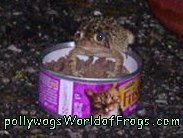 To your left you'll see one such exception to the rule, but believe me, 99% of frogs will not do as you'll see the bufo terrestris doing. There are also documented cases where scientists doing research on some of the glider frogs noticed another species actually eating the eggs out of the glider's foam nests. However, in captivity, I doubt that the frogs or toads would
act in the same way and would most likely starve if you tried to offer them non-moving food sources.
To your left you'll see one such exception to the rule, but believe me, 99% of frogs will not do as you'll see the bufo terrestris doing. There are also documented cases where scientists doing research on some of the glider frogs noticed another species actually eating the eggs out of the glider's foam nests. However, in captivity, I doubt that the frogs or toads would
act in the same way and would most likely starve if you tried to offer them non-moving food sources.
As a note, the toad you see above...I think that frogs learn to manipulate their environment and therefore have learned how to eat out of the catfood can...just a thought...Maybe they are smarter than we give them credit for...but in captivity, go ahead and stick with the rule of feeding them insects that move. ">
 There are several schools of thought on what is best to feed your frog(s).
Here I will attempt to explain what has worked best for me in the over 40
years I have kept them as pets.
There are several schools of thought on what is best to feed your frog(s).
Here I will attempt to explain what has worked best for me in the over 40
years I have kept them as pets.
Wingless flies, sterile fly maggots, springtails, big green flies,
cutworms, termites, roaches, brown slugs,
 earthworms, crickets (at various stages of life)
pillbugs, cabbage worms,
earthworms, crickets (at various stages of life)
pillbugs, cabbage worms,  bollworms, (See picture directly below, right)
caterpillars, fat grubs, aphids, some moth species and tent worms (or 'bag worms')
are all great choices and the basis of a good varied diet for most frogs.
bollworms, (See picture directly below, right)
caterpillars, fat grubs, aphids, some moth species and tent worms (or 'bag worms')
are all great choices and the basis of a good varied diet for most frogs.
Some good choices for smaller species of frogs
include white flies, fruit flies, small white grubs, flour beetle larvae, small red worms, termites, waxworms, ants, (only the worker ants, don't get the
ones that have the large jaws; soldier ants) gnats, leafhoppers, treehoppers, small brown
slugs and aphids.
If you need information on feeding tadpoles and morplhing froglets, see the page on
Tadpole care.
leafhoppers, treehoppers, small brown
slugs and aphids.
If you need information on feeding tadpoles and morplhing froglets, see the page on
Tadpole care.
 Some of these insects are easy to find, and most people make a staple out of crickets.
But frogs tire of eating the same thing all of the time, just as humans do.
Another
important factor to remember when feeding mainly crickets is the amount of
chitin
they contain. That is, their skeletons and wings, being made of a
material similar to our fingernails; can cause your
Some of these insects are easy to find, and most people make a staple out of crickets.
But frogs tire of eating the same thing all of the time, just as humans do.
Another
important factor to remember when feeding mainly crickets is the amount of
chitin
they contain. That is, their skeletons and wings, being made of a
material similar to our fingernails; can cause your
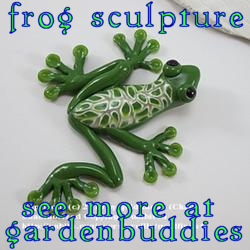 frogs to have digestive problems if fed too much of this matter!
Just make sure to include some the soft-bodied insects in their diets
to keep this from happening. Although impaction is usually caused by stones or the accidental ingestion of another subtrate material, chitin build-up can help create this malady too. Impaction is hard to cure and in most cases will cause the frogs death.
frogs to have digestive problems if fed too much of this matter!
Just make sure to include some the soft-bodied insects in their diets
to keep this from happening. Although impaction is usually caused by stones or the accidental ingestion of another subtrate material, chitin build-up can help create this malady too. Impaction is hard to cure and in most cases will cause the frogs death.
Crickets that have turned white are in the act of shedding, therefore the chitin is removed. If possible, these crickets are good choices to feed the frogs when trying to cut down on chitin. Be sure to pick them up gingerly, as they will become damaged if mishandled when shedding. You still need the bug to wriggle, so the frog will see and go after it.
Mealworms & Waxworms
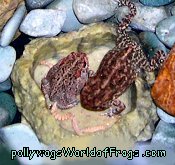 Mealworms are very non-nutritious insects and add little but starch to the diet of any frog eating them.
It is suggested you use them only in a pinch, and get your pet back on the high-protein insects
listed above as soon as possible. If you must use them, try slightly dampening them with mister,
then rolling them in frog vitamin dust for feeders. Offer to frogs in a feeding dish.
Mealworms are very non-nutritious insects and add little but starch to the diet of any frog eating them.
It is suggested you use them only in a pinch, and get your pet back on the high-protein insects
listed above as soon as possible. If you must use them, try slightly dampening them with mister,
then rolling them in frog vitamin dust for feeders. Offer to frogs in a feeding dish. 
 Too many mealworms have been found to cause liver damage in birds.
Too many mealworms have been found to cause liver damage in birds.
Waxworms are a decent addition, and offering them once every few months is alright for your frogs, because of their high fat content. Overfeeding waxworms, superworms & mealworms could also create problems, as the frogs can become "addicted" to them, creating a situation for you when trying to give them their regular dinner menu! Avoid mealworms. Learn to know the difference in the two, as they are related and do look similar.
Feeding Aquatic Frogs
 Aquatic frogs like the pipids can be offered even more foods, among this being live tubifex, as well as small
Aquatic frogs like the pipids can be offered even more foods, among this being live tubifex, as well as small  feeder guppies
and goldfish, large daphnia, (water fleas) and large brine shrimp.
feeder guppies
and goldfish, large daphnia, (water fleas) and large brine shrimp.
Almost every insect named above can be purchased. Some locally, and the rest through the Internet.
 You can purchase the earthworms and crickets at any Bait & Tackle Shop.
You are strongly advised to open the container of worms on site. Sometimes they
are dead or dying. A nasty odor coming from one is testimony enough.
Bait Shops usually sell two types, red-worms and night crawlers. You're
probably best going with the red-worms unless you have a very large frog.
You can purchase the earthworms and crickets at any Bait & Tackle Shop.
You are strongly advised to open the container of worms on site. Sometimes they
are dead or dying. A nasty odor coming from one is testimony enough.
Bait Shops usually sell two types, red-worms and night crawlers. You're
probably best going with the red-worms unless you have a very large frog.
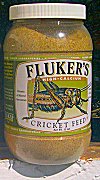 Choose the right-sized crickets for your awaiting pets. And don't "over-buy"
unless you have the appropriate
set-up for them to live at home. Raising your own is a good idea,
the costs will go down, and unlike the Bait shop, you'll now have
"pinheads" available for your smaller frogs. More on this and housing them on the
Raising Insects page.
Choose the right-sized crickets for your awaiting pets. And don't "over-buy"
unless you have the appropriate
set-up for them to live at home. Raising your own is a good idea,
the costs will go down, and unlike the Bait shop, you'll now have
"pinheads" available for your smaller frogs. More on this and housing them on the
Raising Insects page.
Be sure to feed and water the crickets for at least 24 hours before offering them up as food for your pets. Flukers sells many excellent cricket products to help you with this. The gells containing water and calcium supplements help not only to keep the crickets from drowning when drinking, but add the calcium naturally to your frogs' diet. A cheaper alternative is to use a clean, unused kitchen style sponge filled with water and lightly squeezed. Dust it with a calcium tablet you have crushed with a mortar and pestle.
Remember to buy a vitamin and mineral cricket dusting powder as well. This product is used once every two weeks to douse your feeders in before offering them to your anurans. Use of a specialized Cricket dusting bin will help with this task. You can also use a cleaned plastic Hellman's mayonnaise jar with the dust in bottom. After swirling the feeder crickets in it a few seconds, I scoop them up the sides, (leaving loose dust in bottom) and into the frogs' vivariums.
What about Bloodworms?
Many Herpers don't relish the idea of feeding bloodworms to their frogs. Bloodworms have mouth spicules with miniature hooks. They use these to hang onto their own victims. Herpers worry that this can happen to the insides' of their frogs stomachs. The frogs ingest them whole, of course, so this is a true concern. Try Live Tubifex worms for your aquatics instead.
Culturing your own Insects
 The best thing to do is culture your own insects. By doing
this, your frogs will have a constant supply of food on hand at all times.
You will never run out, and the gas, shipping fees and time you save will
help make it worth the extra effort.
The best thing to do is culture your own insects. By doing
this, your frogs will have a constant supply of food on hand at all times.
You will never run out, and the gas, shipping fees and time you save will
help make it worth the extra effort.
 Flies are a great nutritional source of food you can offer your frogs and
one I strongly recommend.
The cultures offered today are sterile and disease-free. They are also
odorless. (The only odor you may get is from their food, if you don't
keep their containment clean!) They are also easy to raise, by following
a few simple rules. I have found that green flies are my favorites to culture.
Their food is not nasty, and these flies can grow fairly large.
If the idea of raising flies is troubling, I suggest you culture the green fly.
They're cleaner than regular black houseflies, and even pretty in abdomen colorations.
Flies are a great nutritional source of food you can offer your frogs and
one I strongly recommend.
The cultures offered today are sterile and disease-free. They are also
odorless. (The only odor you may get is from their food, if you don't
keep their containment clean!) They are also easy to raise, by following
a few simple rules. I have found that green flies are my favorites to culture.
Their food is not nasty, and these flies can grow fairly large.
If the idea of raising flies is troubling, I suggest you culture the green fly.
They're cleaner than regular black houseflies, and even pretty in abdomen colorations.
Fly maggots are also very good and you should offer them to your frogs too. At various stages, the maggot turns from a soft pupae to a harder, 'shell-encased' pupid. They are all capable of being eaten, but they wriggle more the softer they are. Frog's like their food to move, so you'll have better luck with the newbie maggots.
The 'Other' Food sources
 There are dried foods out there. Let's not go there. Dried foods are only
for emergencies, and will only work on a few species, pipids being one. Another
'no-no' on the list is the offering of hamburger or beef liver pieces on a stick. I have learned from
previous experience that eventually your frog may develop 'jerks' and other
reflex afflictions from this. Kind of like the 'ticks and jerks' Robert DeNiro
displayed in the movie "Awakenings". I have no proof of it, but I believe the higher
fat content and difference in a high evolved mammal meat structure versus insect causes the
problem. It has recently become a known scientific fact, that beef liver can create vitamin D and A deficiencies, so is totally unacceptable. Some say its' okay. I would not risk it, even for convenience.
There are dried foods out there. Let's not go there. Dried foods are only
for emergencies, and will only work on a few species, pipids being one. Another
'no-no' on the list is the offering of hamburger or beef liver pieces on a stick. I have learned from
previous experience that eventually your frog may develop 'jerks' and other
reflex afflictions from this. Kind of like the 'ticks and jerks' Robert DeNiro
displayed in the movie "Awakenings". I have no proof of it, but I believe the higher
fat content and difference in a high evolved mammal meat structure versus insect causes the
problem. It has recently become a known scientific fact, that beef liver can create vitamin D and A deficiencies, so is totally unacceptable. Some say its' okay. I would not risk it, even for convenience.
There are exceptions to the above, of course. Frogs like the African bullfrog or ceratophrys species both are known to eat small mammals in the wild, so for certain species it may be alright. Since frogs can get and carry salmonella though, may be another reason to stay away from raw hamburger!
Live tubifex worms are awesome for aquatic frogs. Very high in vitamin
D, protein and low in fat. My white Xenopus Laevis frogs freak out when I throw
these guys in! Now that I think about it, they freak on any food thrown to
them, but you can tell they especially like these. You can usually find
live tubifex at the larger pet store chains.
Most people don't know that you can raise your own, but there is an easy method.
I describe the simple process here:  Culturing Tubifex Worms.
Culturing Tubifex Worms.
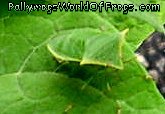 Other foods you can offer are the local insects you will have each
spring, summer and fall. Small grasshoppers are good, but only if you're not the
"fluffy" type, as I'd recommend pulling the large jumping legs off first. Don't
forget flying locusts,(pull off the wings) or "cicadas" as they are properly called,
and horn worms. Horn worms love plants from the "Nightshade" family, so you'll
find them on tomato plants. Those found on tobacco plants should be avoided, as the tobacco juice inside the worm is not good for your frogs. Use only those from the
tomato plants.
Other foods you can offer are the local insects you will have each
spring, summer and fall. Small grasshoppers are good, but only if you're not the
"fluffy" type, as I'd recommend pulling the large jumping legs off first. Don't
forget flying locusts,(pull off the wings) or "cicadas" as they are properly called,
and horn worms. Horn worms love plants from the "Nightshade" family, so you'll
find them on tomato plants. Those found on tobacco plants should be avoided, as the tobacco juice inside the worm is not good for your frogs. Use only those from the
tomato plants.
Remember, if you are going to gather caterpillars from a vegetable garden, make sure they have not been sprayed with any poisons or pesticides. If its' an organic garden, you and the frogs are in luck, as these worms are fat and juicy! Frogs snatch 'em up! Any other insects you catch from the wild follow the same precaution. If you are not sure that the insect is pesticide free, you are better off using insects you have purchased or raised yourself.
Beneficial Insects
Insects you should not offer your
frogs are the beneficial types. This would include bees, wasps,



 spiders, (not that many
would attempt!) ladybugs; larvae or adult, lacewings, water boatmen, butterfly caterpillars, praying
mantis and the larvae of dragon flies. (A praying Mantis will attack the frog, another
reason not to use him!) These insects all do various great things
for man and the environment and should in no way be used as food for your frogs.
There are pictures of a few species on this page so you will be able to recognize them.
spiders, (not that many
would attempt!) ladybugs; larvae or adult, lacewings, water boatmen, butterfly caterpillars, praying
mantis and the larvae of dragon flies. (A praying Mantis will attack the frog, another
reason not to use him!) These insects all do various great things
for man and the environment and should in no way be used as food for your frogs.
There are pictures of a few species on this page so you will be able to recognize them.

Unbeneficial to the environment (as far as we know) but should not be fed to frogs would be millipedes and stinkbugs. They have a hard, chitinized shell and also create a noxious odor when frightened. Frogs would not enjoy their flavor.
ladybugs are actually harmful to frogs, so don't under any circumstances offer them to your pets.
How often to feed Frogs
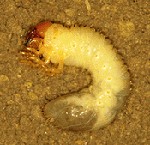 Most frogs maintain good health consuming food every other day to every 3 days.
Feed them the appropriate sized-insects and enough for each frog to
have 4-7 insects on feeding day/eve. Smaller or slower frogs in a vivarium cannot
always compete with the quicker and larger frogs. If you see this is the case,
group them into separate vivariums according to frog-size to insure they will
eat too. Always remove any dead or uneaten food within 2 hours of the initial feeding.
Most frogs maintain good health consuming food every other day to every 3 days.
Feed them the appropriate sized-insects and enough for each frog to
have 4-7 insects on feeding day/eve. Smaller or slower frogs in a vivarium cannot
always compete with the quicker and larger frogs. If you see this is the case,
group them into separate vivariums according to frog-size to insure they will
eat too. Always remove any dead or uneaten food within 2 hours of the initial feeding.
Remember too, that many frogs from cooler climates actually hibernate in nature, and would not eat at all during the cooler months. Frogs rest during this time, their heartbeat slowing to as low as 3 beats per minute. Your frogs will not be hibernating, as your home will be too warm to trigger this event. But in cooler weather, your frog will tend to eat less.
Unless you are  cycling your frogs in anticipation
of breeding, or have a very ravenous species, (African bullfrogs as example) the
"every other day" feeding rule should produce happy and healthy frogs.
cycling your frogs in anticipation
of breeding, or have a very ravenous species, (African bullfrogs as example) the
"every other day" feeding rule should produce happy and healthy frogs.
Try to schedule feedings at the same time. You'll begin to see that your pets are waiting for you as you walk up to their vivarium with the new meal!
 Frog and Toadlets will also need to eat more often than adults. As they are growing
quickly, make sure they receive adequate calcium supplements and the
smaller insects that they can easily place in their mouths. Read more
about feeding young frogs on the Tadpole Care page.
Frog and Toadlets will also need to eat more often than adults. As they are growing
quickly, make sure they receive adequate calcium supplements and the
smaller insects that they can easily place in their mouths. Read more
about feeding young frogs on the Tadpole Care page.
Some species of frogs are more ravenous than others. Poison dart frogs, Bullfrogs, African clawed frogs, Whites treefrogs and Firebellied toads are just a few of them. Read more about different species of frogs and whether aggressive eaters or not on Frog caresheets page. There you find find an extensive clickable link menu to lead you to your species of interest.
My Frogs won't eat!
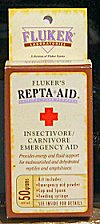 If you just got the frog, you should have actually gotten the clerk who helped you box up the frog feed him in front of you. If you forgot to do this, you should try to feed him when he's home and in the quarantine tank. It does
not mean he will eat, but the attempt is a good one. Frogs are easily stressed, and
don't get disappointed if he does not eat for a day or so while adapting to his new
home.
If you just got the frog, you should have actually gotten the clerk who helped you box up the frog feed him in front of you. If you forgot to do this, you should try to feed him when he's home and in the quarantine tank. It does
not mean he will eat, but the attempt is a good one. Frogs are easily stressed, and
don't get disappointed if he does not eat for a day or so while adapting to his new
home.
If he does not eat within a week or so, and you have kept the area quiet and handling to a bare minimum (You should really try not to hold him at all after placing in his quarantine tank, it stresses him even more) then you can try purchasing a good multi-vitamin product called "Flukers Repta-Aid". This should help in stimulating his food-drive. Have some crickets handy. It usually takes a few hours to work.
Don't over-use this product. It is a concentrated vitamin formula, and too much of
it is not good either. Use it only when new arrivals or a sickly frog is experiencing a temporary
lapse in his normal eating schedule. It is an excellent product to keep in
your Frog's "Medicine cabinet" just in case it is needed.
In all except severe cases, regularly dusting your insects with the powdered  T-Rex's Tree Frog Dust
once every couple of weeks should be enough to keep your frogs healthy and eating properly.
T-Rex's Tree Frog Dust
once every couple of weeks should be enough to keep your frogs healthy and eating properly.
Another thing to mention at this juncture is  impaction. A frog
may go off his food should this occur, and eating more is definitely not what you want
right now! Click the underlined link-word above to read up on this often-deadly malady.
impaction. A frog
may go off his food should this occur, and eating more is definitely not what you want
right now! Click the underlined link-word above to read up on this often-deadly malady.
Use a Feeding dish
Some of the insects you feed your frogs can be kept contained in a dish. This makes it easier to remove them, as stated above. Use a small ceramic or glass dish that you have sunk into the substrata (ground) until it is almost level with the ground surface. The Herp trade also makes small plastic bowls that look like concaved rock, these 'match' the look of a vivarium and are of value. Insects like pillbugs, maggots, some caterpillars and others will stay in the bowl. The frogs will soon learn this is the place to come to find their food. Clean the bowl thoroughly after each feeding is completely finished.
Feeding Morphs and Tadpoles
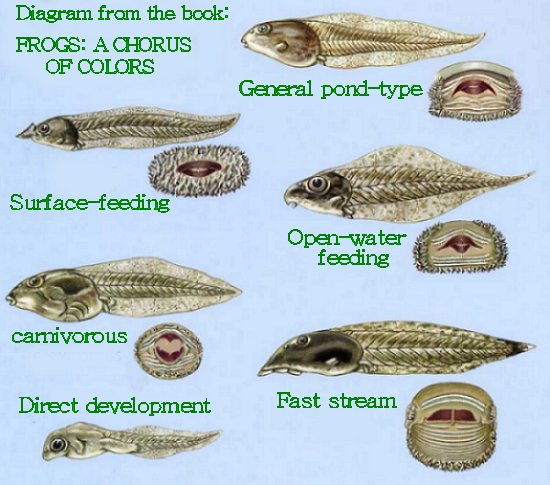 The different mouth forms tadpoles have can tell you a lot about what kind of food it
will need in order to thrive and grow. To get a better look, click on the photo for
a larger view. Also on click is mouth descriptions.
The different mouth forms tadpoles have can tell you a lot about what kind of food it
will need in order to thrive and grow. To get a better look, click on the photo for
a larger view. Also on click is mouth descriptions.
Some frog species have a need for special food sources in their diets, and I'll list
a few of them here. They are strongly recommended!. The Hymenochirus tadpoles
must be fed infusoria.
Those who breed dendrobates also recommend the springtails, as listed. There
is also a  Tadpole to Morph Table found
on the Tapole Care Page, listing other species particular food requirements.
Tadpole to Morph Table found
on the Tapole Care Page, listing other species particular food requirements.
Newly morphed froglets can also be fed 

 Field plankton.
Field plankton.
Click Here to see the Special Care Tadpole & Morphlings feeding Table
For more information on raising Infusoria and Daphnia cultures for your Dwarf pipids, see this Offsite link: Why Infusoria is Necessary
Martin, I hooked the above link up to your index page in anticipation of the proper link :)Keeping Slugs, Snails & Fish with frogs
 Fish can carry trematode worms that will infest your frogs when they change into a free-swimming
form in their life cycle. Feeding/Keeping them with your frogs can potentially
end up in health concerns for your frogs. The worst thing about this parasite, is by
the time you usually find out something is wrong with your pet, it's too late to help him.
Fish can carry trematode worms that will infest your frogs when they change into a free-swimming
form in their life cycle. Feeding/Keeping them with your frogs can potentially
end up in health concerns for your frogs. The worst thing about this parasite, is by
the time you usually find out something is wrong with your pet, it's too late to help him.
Ribeiroia snails can also carry flatworms and these parasites have been linked to some of the frog deformities in North America. In rare cases, humans have been infected with the often deadly Lung Flatworm, where the parasite has species jumped one of the hosts and got one of us instead!
Unless you have a known clean source, (over 18 months, captive-bred) I strongly suggest you keeping them away from your frogs.

 Most froggers "strip" the earthworm before
feeding it to the frog. This insures that the frog will not get constipated.
To do this, use your index and thumb to firmly grasp the earthworm near its' head.
Run your fingers down the length of its' body, going with the grain of the earthworm's skin. If you've done it
right, you will see the worm "poop" out the dirt. If not, you just blew it's head off. Either way, feed to frog. You'll get the hang of it!
Most froggers "strip" the earthworm before
feeding it to the frog. This insures that the frog will not get constipated.
To do this, use your index and thumb to firmly grasp the earthworm near its' head.
Run your fingers down the length of its' body, going with the grain of the earthworm's skin. If you've done it
right, you will see the worm "poop" out the dirt. If not, you just blew it's head off. Either way, feed to frog. You'll get the hang of it!

 Referring to page 1450, The International Wildlife Encyclopedia, Great Britan.
Referring to page 1450, The International Wildlife Encyclopedia, Great Britan.


 If you live near an open, unpolluted grain or other
field area, you can collect Field plankton by running a large-mouthed mesh net
through the open field. The tiny insects and larvae you find in the net are the
resulting 'field plankton'.
If you live near an open, unpolluted grain or other
field area, you can collect Field plankton by running a large-mouthed mesh net
through the open field. The tiny insects and larvae you find in the net are the
resulting 'field plankton'.



 An additional note on the spiders to add here:
I was reading through some info from the German scientists of Inibico while working in Peru who actually witnessed spiders
stinging and killing some dendrobatid frogs they had come across!
An additional note on the spiders to add here:
I was reading through some info from the German scientists of Inibico while working in Peru who actually witnessed spiders
stinging and killing some dendrobatid frogs they had come across!


